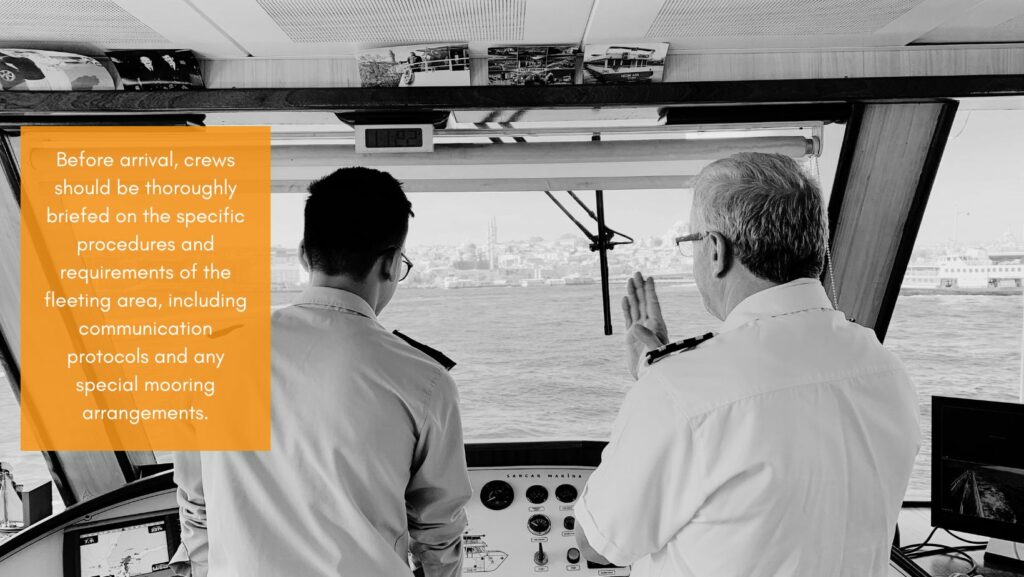
Fleeting operations require careful planning and coordination, as they involve the assembly, disassembly, and maintenance of barge tows in a way that maximizes space utilization while ensuring safe navigation in waterways.
As such, understanding barge fleeting is fundamental for logistics professionals, mariners, and port authorities, as it impacts the efficiency of cargo transportation, the scheduling of shipments, and the overall flow of goods in the supply chain. But it is also important for barge and transport companies to understand fleeting, so as to better optimize their resources, reduce delays, and help ensure smooth operation throughout their journeys.
Evaluating Fleeting Locations
When there are choices available for fleeting and harbor location, evaluating those locations can be as important as the fleeting itself. Of course, you can only make use of a fleeting location if it has availability on the date you’ll need, so it’s vital to determine what type of fleeting location it is and reserve a place for your barge if required. And for some trips, you won’t have more than a single option. But when choices are available, making the right decision can help ensure that you minimize your costs and stay compliant.
Consider the types of barging facilities first. Some facilities are “open fleet,” meaning they’ll take barges as long as they have available space, allowing for “drop-in” service. Others are “closed feet,” requiring companies to arrange to use their facilities in advance and don’t take barges on demand.
Likewise, just as you shouldn’t do business without carrying insurance on your barges, you shouldn’t use a fleeting and harbor facility that doesn’t carry insurance for the barges in its care. You’ll want to ensure that the facility’s insurance covers not just the barge itself but any cargo it’s carrying, if loaded, or that your own insurance will provide coverage in this situation if not.
Physical Considerations and Infrastructure
When evaluating a potential fleeting location, operators should prioritize water depth, ensuring it is adequate for both loaded and unloaded barges, thereby preventing grounding and facilitating easy access. Proximity to major shipping routes is also crucial, as it reduces transit times and enhances the operational efficiency of moving barges to and from the fleeting area. Furthermore, the area’s infrastructure, including the availability and condition of mooring facilities, is a critical factor to consider. If a facility has aging or damaged equipment, the risk of an accident increases dramatically.
Location Policies
Reputable barge fleeting areas adhere to comprehensive procedures and policies covering the arrival and departure of barges, including strict standards for the physical condition of barges and the quality of mooring ropes and wires. These policies should also dictate the presence of personnel during operations and establish clear expectations for the towing company and towboat operator. If you can’t get these policies in writing before committing to a fleeting location, you may open yourself up to liability were something to go astray during the fleeting operation.
Additionally, evaluating these policies beforehand can help you get a feel for whether the fleeting operation will move quickly but safely and avoid adding excess delay or if you might end up waiting in line, burning precious time and money.
You should also choose locations that proactively inspect incoming vessels, focusing on the barge’s cavels, line quality, and watertight integrity, with specific criteria for rejecting barges based on their condition. While a focus on barge maintenance may sound counterintuitive at first, you don’t want your barge near other barges that may be undergoing these issues, as they could put yours at risk.
Regulatory Compliance
You should choose a fleeting operation that complies with the limitations of their fleeting area permit, considering barge numbers and configurations. Failure to do so could potentially result in your company ending up in legal issues if the fleeting operator was caught doing something non-compliant.
It’s important to make sure that they have a high water plan that outlines when additional securing measures are needed and details the conditions under which operations must be adjusted or halted to ensure safety. It should also include provisions for regular checks on mooring equipment and barge conditions, as high water conditions can lead to the highest stress on the situation, potentially leading to the worst-case scenario—a runaway barge.

Checklist for Barge Fleeting
Here’s a quick overview of questions to ask when selecting a barge fleeting location:
- Location
- Is the location convenient for your shipping route?
- Is the water deep enough for your barges?
- Is the equipment in good shape?
- Availability
- Is the facility open or closed?
- Does it have availability on the dates in question?
- Facility
- Does the facility have insurance?
- Does it have clearly written policies?
- Does it inspect incoming vessels?
- Does it adhere to federal, state, and local regulations?
- What does it require you or your crew to provide?
Preparing Your Crew for Barge Fleeting
Before arrival, crews should be thoroughly briefed on the specific procedures and requirements of the fleeting area, including communication protocols and any special mooring arrangements. The crew needs to conduct a comprehensive check of the barge’s condition, ensuring that it meets the fleeting area’s standards. Communication with the fleeting area’s control or management should be established well in advance to confirm availability and receive any last-minute instructions.
As the barge nears the fleeting area, the crew must vigilantly monitor river conditions and weather forecasts, adjusting their approach as necessary to account for currents, wind, and other environmental factors. Safety gear should be readily accessible, and all personnel must be familiar with emergency procedures, including the use of communication and emergency equipment, to ensure a safe, efficient transfer of the vessel to the fleeting operation.
Conclusion
Success in choosing your fleeting and harbor locations is all about getting the little things right. As an owner or operator of barges, you might not always be on hand to make sure everything that needs to happen goes the way it should. With BargeOps’s complete electronic deck log, you get unparalleled visibility of your fleet’s performance, enabling you to streamline tasks like fleeting. To learn more about what BargeOps can do for your fleet, schedule a free demo today.


